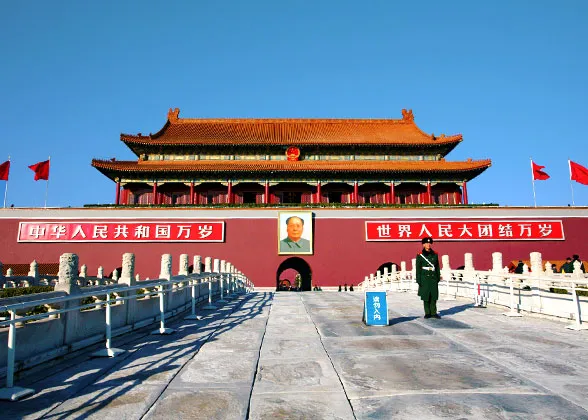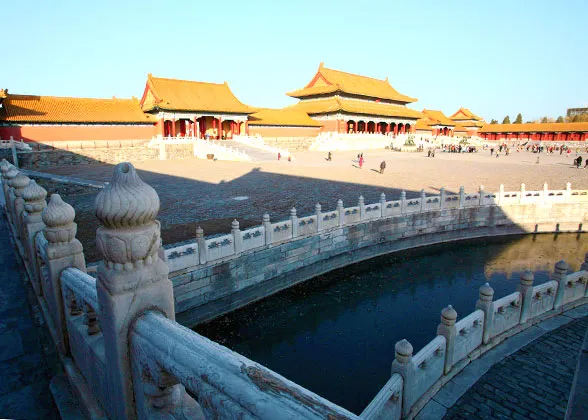Inner Golden Water River - A Giant Snake Hidden in Forbidden City
Facts of Inner Golden Water River
Source: Jade Spring Hill (Yuquanshan)
Length: 2,100 meters (6,890 feet)
Width: 2 meters (6.6 feet) - 11.8 meters (38.7 feet)
Depth: 4 meters (13 feet)
Riverway: Flows in Forbidden City from northwest corner - West Prosperity Gate - Gate of Martial Valor - Gate of Supreme Harmony Square - Hall of Literary Glory - East Prosperity Gate - Flows out from southeast corner
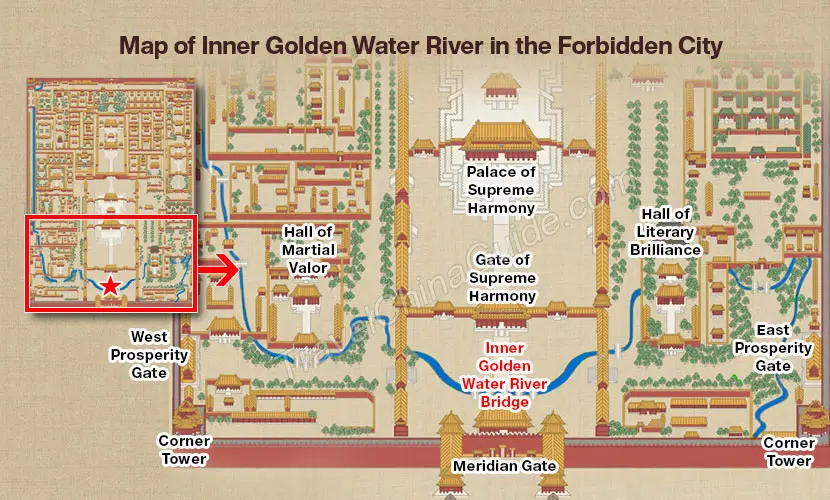 |
| Map of Inner Golden Water River |
Why was the Inner Golden Water River in a snake shape?
From a bird’s eye view, the river is exactly the shape of the head and neck of a snake. At the point where the Inner Golden Water River emerges from the Forbidden City, the river way turns and twists and shows several s-shaped curves. Southeast of its outflow, the designers cleverly shaped the outlet into an inverted triangle, resembling a snake's head. This design is deeply rooted in the symbolism of snakes in ancient China, along with some aesthetic and practical value.
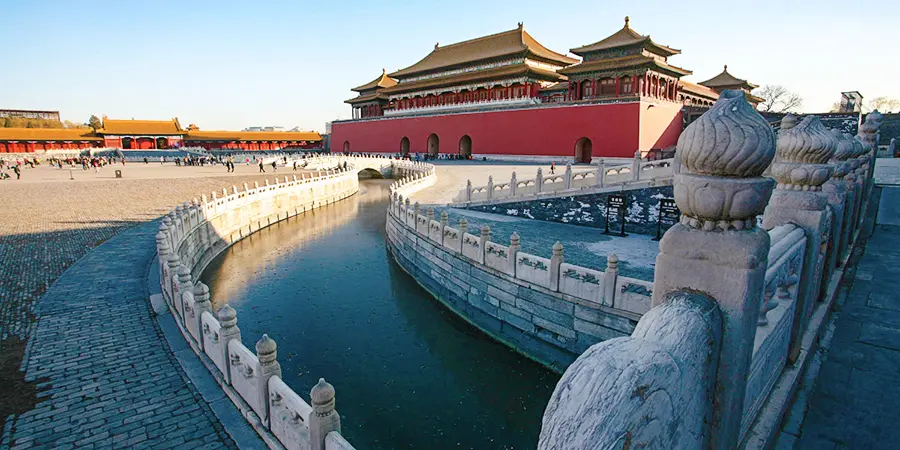 |
Symbols of Snakes: Protection, Power, & Offspring
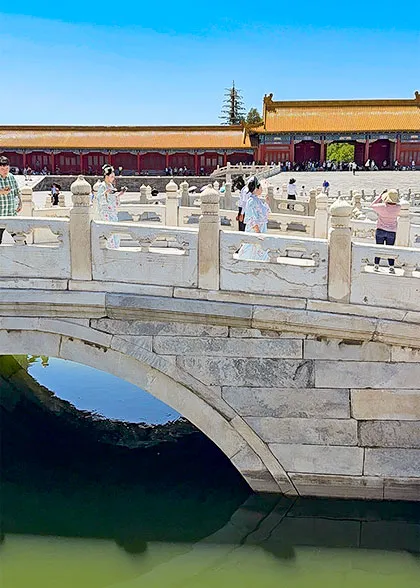 |
| Walking on the Inner Golden Water River |
One of the reasons to design the Inner Golden Water River in a snake shape is that the ancients believed that snakes are the household deity that can protect the house. People who designed the Forbidden City regarded it as a huge house that needed protection.
Furthermore, Nvwa, the goddess who created humanity in Chinese mythology, has the body of a snake and the head of a human. By incorporating this snake-shaped design, the emperor hoped to invoke the divine power of the goddess and be blessed with numerous offspring.
Breaking Symmetry, Adding Vitality
The Inner Golden Water River is an important part of the Forbidden City’s architectural landscape. Its winding path breaks up the formal symmetry of the palace's axial design, adding the vitality and beauty to the buildings.
Moreover, the snake-like design of the river also helped a lot for timely firefighting, which will be introduced in details the next part.
Main Functions of the Inner Golden Water River: Fire Protection and Flood Control
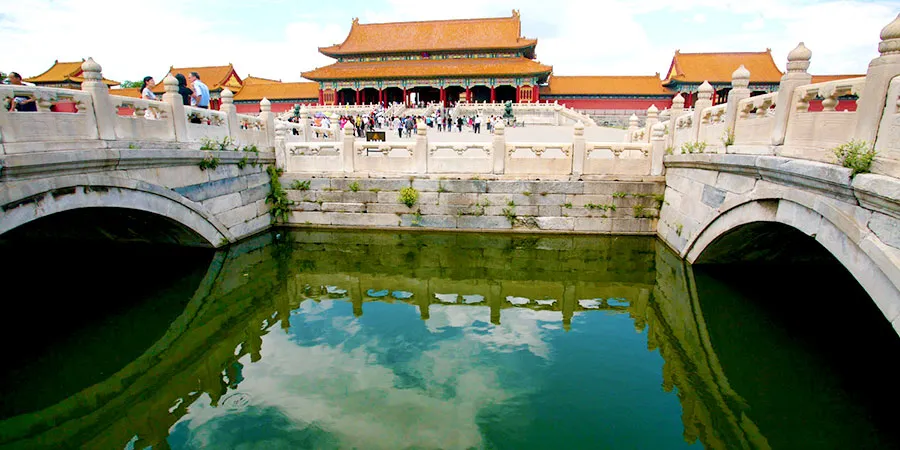 |
The Inner Golden Water River provided sufficient and timely water to put out fires in the ancient buildings due to its ample source and winding snake design that makes it close to various palaces. The ancient buildings in the Forbidden City are mainly built of wood, and the eaves of the buildings are decorated with oil-based flammable materials.
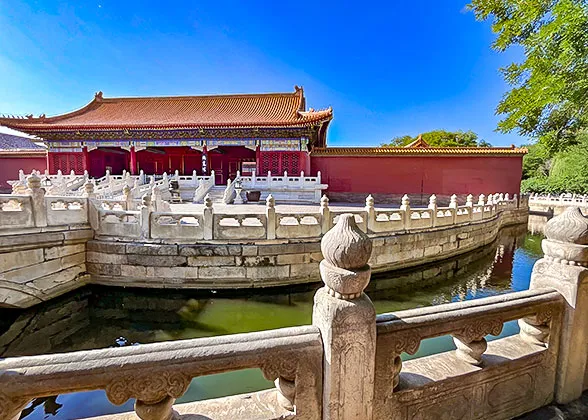 |
| Inner Golden Water River in front of Martial Valor Hall |
Although there are were 72 wells in the Forbidden City, they located far and were too limited to meet the water demand once a fire breaks out. Thanks to the Inner Golden River, the Forbidden City had been survived many times from fire, like the fires in 1624 at the side halls of the Meridian Gate, and again in 1626 at the paint workshop of the Hall of Martial Valor(Wuyingdian).
Serving as the terminal of the drainage system of the Forbidden City, the Inner Golden Water River collects water from the rooftops, ground, and underground canals, guiding it out through the southeast corner and merging it into the moat.
The rain increases dramatically in this period from June to mid-September (Beijing's wet season), but there has never been a problem of water accumulation in the more than 9000 rooms of the Forbidden City. Even a rainstorm does not affect it, which demonstrates the benefits of an excellent drainage system.
Auxiliary Function: Providing Ice
 |
Why named "Inner Golden Water"?
The name "Golden Water" is derived from the ancient Chinese five-element theory, which relates "golden" with the western element of "metal", as the source of the Inner Golden Water River is the Jade Spring Hill to the west of the Forbidden City. According to the theory, "metal" generates "water", hence the inclusion of "water" after "golden" in the name.
In addition, the Jade Spring Hill was divided into two streams, with one flowing inside and the other outside the Forbidden City. Consequently, the stream within the city was named the Inner Golden Water River.
|
|
History of the Inner Golden Water River
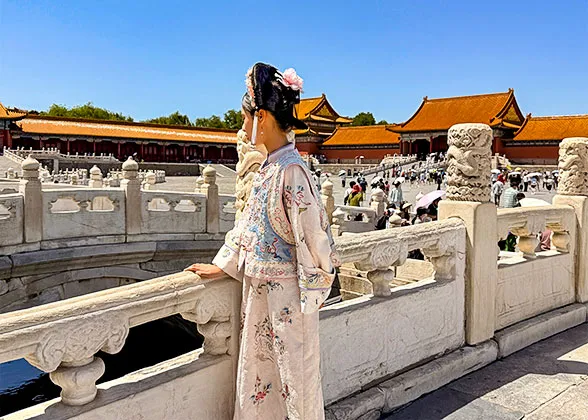 |
| Admiring the River in Ancient Chinese Costume |
When was the Inner Golden Water River built? Back in 1267, the Yuan Dynasty emperor embarked on a grand project to bring the waters of Jade Spring Hill into the Beihai Lake. By 1274, the project completed and the river was named "Golden Water".
From 1406 to 1420, Emperor Chengzu transformed the original Golden Water River into two streams flowing inside and outside the Forbidden City and respectively named them Inner and Outer after Golden Water, from which the Inner Golden River took form. Today, as you walk alongside this river, you're tracing a 600-year-old history from the Ming Dynasty.
Collective Suicide at the Inner Golden Water River
In the year 1644, during the collapse of Ming Dynasty, around 300 palace maidens, to preserve their honor and virtue, chose to collectively suicide by jumping into Inner Golden Water River. This tragic event is explicitly recorded in the History of Ming Dynasty as one of the most painful scenes in the history of the Forbidden City.
